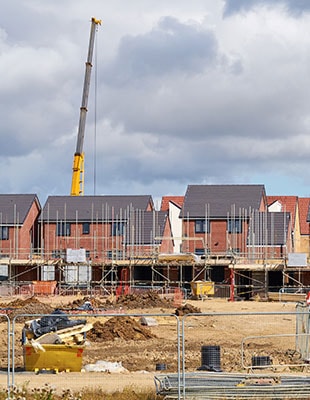The recently published National Planning Policy Framework highlights how difficult housing reform can be. Can we expect better from the outcome of a general election, asks Simon Rawlinson.
The Christmas break is some way be behind us now, but here is one more classic cracker joke: “How do you eat an elephant? The answer, of course, is: “In small pieces”.
Michael Gove seems to be a fan of the joke as “in small pieces” appears to be the latest solution to England’s planning conundrum, unveiled by the secretary of state at the Department for Levelling Up, Housing and Communities as part of the updated National Planning Policy Framework (NPPF) published last month.
The publication came more than three years after the 2020 white paper Planning for the Future. What remains of an expansive vision for a plan-led, rules-based system delivering 300,000 homes per annum is now largely in place, bar the publication of national development management policies (NDMP).
When it comes to planning, “in small pieces” means a bottom-up focus on getting local plans in place and delivering against them. It is much less ambitious than the “decisive action” that was promised in the 2020 white paper and, as a result, is unlikely to deliver on promises of “bridging the generational divide” or recreating an “ownership society”. These aspects of a broken housing system have been left to be fought over in the impending general election.
The most controversial changes to the new NPPF included an announcement that, in future, housing need targets will be advisory and requirements for five-year housing supply will be eased for local authorities that have an up-to-date plan. There are multiple performance measures designed to increase accountability for performance as well as additional resources such as the £24m planning skills delivery fund. The response to the reforms has been mixed.
Most commentators agree that the NPPF will not deliver the target of 300,000 homes per year, but there is a more nuanced debate on whether the updated system will deliver better planning outcomes – in particular by incentivising local authorities to put local plans in place and to meet their housing delivery targets (HDTs). One new provision is the requirement for planning officer decisions to be respected by members of planning committees, which one would like to think will result in better decision making.
The issue of better planning outcomes is very important and often gets obscured by arguments over annual housing targets. To be sustainable, a planning system relies on the consent of local people.
In his launch speech at the RIBA last month, Gove described five preconditions for gaining consent: beauty, infrastructure, democracy, environment and neighbourhood – helpfully summed up in the cheeky acronym BIDEN.
Whether or not these specific factors are the right ones to consider, the legitimacy point is important, because public consent is probably the best way to switch stakeholders from NIMBYs into YIMBYs.
Labour is positioning itself as the party of the YIMBY, and its housing recovery plan is aimed squarely at increasing the rate of housebuilding. Appropriately for an electoral centrepiece, it is a big-picture vision featuring new towns, mayoral development corporations and major reforms to compulsory purchase of housing land, together with the scrapping of the updated NPPF on day one.
Labour’s plans are ambitious, including delivery of 1.5 million homes over a five-year term. Electorally, this makes a lot of sense as the party’s target demographics include those priced out of the market. It is pleasing to see that housing is likely to be promoted hard as an electoral dividing line because it will spur a much-needed policy debate.
Hard choices are needed. The centre-right think-tank Policy Exchange’s recent report, Property-owning Democracy, highlights the continuing need for radical reform. The report is focused on ownership and how this creates a stake in society.
Falling home ownership rates are the biggest challenge and the report advocates a rules-based approach to residential planning to increase rates of build. Readers with a long memory will recall that a rules-based – as opposed to scheme-by-scheme – consenting model was central to former housing minister Robert Jenrick’s reforms.
These fell at the first hurdle due to voter and MP hostility to loss of control. Policy Exchange’s continuing interest comes from a belief that the replacement of the current system should provide greater certainty, should increase land supply and in turn should encourage competition focused on housing quality rather than land acquisition.
Looking forward to this year’s housing debate, I am wondering whether it will focus on material issues or false opposites. At the moment it is the latter. Once you get into the detail, many of the dividing lines between the parties are more apparent than real.
Take for example the issues of housing need and the green belt. Under the new system, planning authorities should find it very hard to justify not delivering sufficient housing to meet needs assessments. Similarly, there are already provisions to redevelop brownfield land in the green belt, which is Labour’s big idea.
Gove also proposes housing development corporations, for example in Cambridge, and even CPOs can proceed without the premium costs of hope value for land, subject to consent by the secretary of state. In practice, even though a fundamental change is needed, many of the policy differences highlighted by the parties so far are not that substantial.
With all of the main political parties promising a step change in housebuilding, then there clearly is a debate to be had and I would prefer it to cover all aspects of housing delivery.
Given the recent revelation, originally reported in the Financial Times, that only one third of the £4.2bn Housing Infrastructure Fund has been spent since it was established in 2017, there remain many more barriers than planning including tenure mix, viability and the whole process of funding allocation and approvals, as well as the non-stop merry-go-round of housing ministers that we have experienced since 2010.
So, let’s make the best use of this year’s electoral debate on solving the UK’s housing crisis to properly communicate the challenge. There are no easy solutions, and our politicians should know this.
They should also recognise that public support will be central to turning grand plans into reality. If a “small pieces” approach to planning is as far as consent will presently allow, then the election really does need to trigger a completely different national discussion on housing.
Article originally published in Building magazine.





